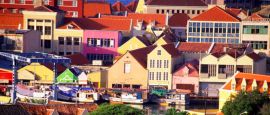This nature reserve in northwest Curaçao is dominated by St Christoffel Mountain. Here you can wander into several awe-inspiring caves decorated with Arawak Indian paintings and wonder at the park's unusual rock formations, exotic birdlife, iguanas and timid Curaçao deer.
Curaçao things to see and do
Tourist offices
Address: 80 S.W. 8th Street, Suite 2000 , Miami, FL, 33130, United States
Tel: 305 423 7156
www.curacao.com
Historic Willemstad is edged by the island's natural harbour, Schottegat, where Curaçao's famous floating market takes place. Get a dose of local culture and observe dozens of colourful barges full of Venezuelan wares and agricultural produce. Haggle hard, because the vendors will.
No visit to the island is complete without tasting Curaçao's famous eponymous liqueur, made using dried peel from the laraha citrus fruit. For a complimentary tipple, head to the Willemstad distillery and sample a glass of the original recipe, which dates back to 1886.
Delve into a string of hiking trails in this compact bird-filled nature reserve that boasts stunning views of Curaçao's rugged north coast. Sea turtles breed in the protected waters below and the conservation zone is renowned for its otherworldly limestone grottoes and fossilised caves.
Curaçao's warm and clear seas are prime for watersports – from swimming in sheltered coves to windsurfing, sailing, snorkelling, scuba-diving, deep-sea fishing and water-skiing, there are many aquatic activities to keep you entertained. Professional watersports schools abound, offering classes for beginners and groups.
See historic Willemstad on a narrated tour aboard an open-sided land train, which departs Fort Amsterdam to the sound of clanging bells. The “train” then journeys downtown through Willemstad's pretty pastel-coloured, red-roofed colonial streets. It’s a fine way to see the UNESCO old town.
Visit the Mikvé Israel Emanuel Synagogue and learn more about the sacred building's history at the nearby Jewish Cultural Historical Museum. The oldest synagogue in the western hemisphere, services are still held weekly and the floor is scattered with imported sand.
Costumed partygoers fill the streets during Curaçao's Carnival season, when ancient Catholic rites and African-Caribbean traditions fuse, creating a riot of colour, pomp, and revelry. One of the largest and longest lasting carnival spectacles in the Caribbean, merrymaking begins early January and continues until early March.
This fascinating anthropological museum includes an exhibition on the history of the slave trade in the Americas. The museum boasts the largest African collection in the Caribbean and was opened in 1999. Poignantly, the building is situated on the site of a former slave yard and merchant's home.
Visitors can explore Curaçao's magnificent underwater world without getting wet thanks to the SeaWorld Explorer submarine, which takes passengers of all ages on a subaquatic tour of offshore wrecks and coral reefs. Huge shoals of rainbow-hued tropical fish dart around the windows, allowing privileged views of sponge gardens and marine life.
At Blue Bay Golf Club, mischievous sea breezes make the par-72, 18-hole course a battle of wills, with lagoons, small lakes and a plunge ravine into the sea. Have a camera ready for the signature fifth hole, with a setting of rugged clifftops and open skies.
Pop into Curaçao Museum and browse a fascinating collection of antiques and art. Housed in a building dating back to 1853, the museum also contains artefacts from the indigenous Caiquetio tribes and has a pretty garden, which is used to host moonlit musical jamborees.
Do you have any Feedback about this page?
© 2026 Columbus Travel Media Ltd. All rights reserved. No part of this site may be reproduced without our written permission, click here for information on Columbus Content Solutions.








 You know where
You know where